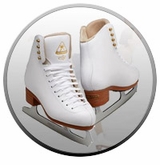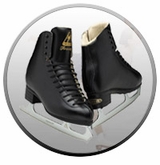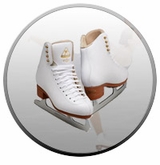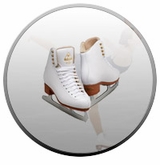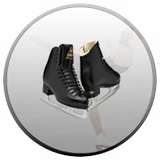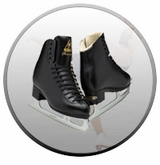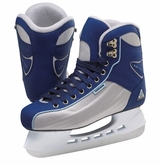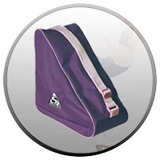Figure Skating Spins
Figure skating spins are identified by figure skaters spinning or twirling on a single spot (normally). The ability to perform figure skating spins requires excellent balance, and the ability to withstand the dizziness that inevitability comes from spinning. There are many different types of figure skating spins, and multiple variations for each spin. Figure skating spins can be performed as sitting spins, upright spins, flying spins, traveling spins, on one or two feet, and forwards or backwards. The criterion for a “good” spin is determined by: the speed of the spin; the body control of the skater; and the ability of the skater to spin without traveling (unless it’s a traveling figure skating spin).
For beginners, the two-foot figure skating spin is probably the best spin to learn first. The two-foot spin is performed on the skating blades versus the toe pick. As beginners get comfortable with the two-foot spin, they can begin working on the one-foot spin by simply lifting one foot while performing the two foot spin. For beginners, the goal should be to perform two or three revolutions during a spin. The next step in learning to perform figure skating spins is to spin on the toe pick. Please see below for more information on many of the various types of figure skating spins.
Upright Spins
Upright figure skating spins are spins simply performed while in an upright position. Upright spins are considered the easiest of all figure skating spins, and are normally the first type of spins figure skaters learn. The figure skater may execute the upright spins in either direction; forwards or backwards. The basic upright spins are the two-foot, and one-foot figure skating spins.
Two-foot Spin
To perform the two-foot figure skating spin the skater will stand with the feet approximately shoulder width apart. With good posture, the skater will place one of the toe picks into the ice and use the arms, head, and shoulders to gain momentum for twirling the body. Just as the spin starts, the skater should slightly bend the knees and straighten them as the spin begins. One of the purposes of the two-foot figure skating spin is to help the skater become accustomed to the sensation of spinning. As mentioned, the two-foot spin is normally one of the first (if not the first) figure skating spins beginning figure skaters will learn to perform.
One-foot Spin
Once a beginning figure skater has conquered the two-foot figure skating spin, he or she will probably find the transition to spinning on one foot relatively easy. To perform the one-foot figure skating spin, stand with the feet approximately shoulder width apart. With good posture, place one of the toe picks into the ice and use the arms, head and shoulders to gain momentum for twirling the body. Just as the spin starts, the skater should lift one leg from the ice, slightly bend the spinning knee, and straighten the spinning knee as the spin begins. Some figure skaters may find the one-foot figure skating spin easier to perform than the two-foot spin.
Scratch Spin
The scratch spin is performed in an upright position with the legs crossed, and the arms extended over the head or across the front. The scratch figure skating spin can be executed on a back outside or back inside edge, and the spin is accomplished at an extremely fast rate. The scratch spin is sometimes performed at the end of the figure skating program as a part of the grand finale.
Biellmann Spin
Precisely who invented the Biellmann figure skating spin is uncertain. However, this figure skating spin is named after Denise Biellmann, a figure skater from Switzerland. Denise Biellmann introduced the Biellmann spin to the world in the 1970s. The Biellmann figure skating spin is an upright spin that requires great flexibility, and is mostly performed by women. During the Biellmann spin, the figure skater; arches the back, lifts and grabs one skate and holds it high over the head, and spins on the other skate. The figure skater can hold the lifted ice skate with one or two hands.
Camel Spin
It is widely believed that the British figure skater Cecilia Colledge invented the Camel figure skating spin in 1935. During the Camel spin the figure skater leans forward at the waist, with the free leg straight behind and parallel with the upper body. The arms are straight out to the side, one pointing toward the ice, and the other pointing toward the ceiling. There are multiple variations to the Camel figure skating spin, and it can be performed either forward or backwards. Some of the noteworthy variations are the: outside edge camel spin; inverted camel spin; Hamill Camel spin (named after Dorothy Hamill); Illusion spin; butterfly spin; layover spin and the layover camel figure skating spin.
Cross-Foot Spin
The cross-foot figure skating spin is performed on two feet and is variation of an upright spin. The cross-foot spin is identified by the figure skater crossing the free leg over the skating leg and spinning on the toes of both skates. The cross-foot figure skating spin is considered a difficult spin to learn, and a challenge for even the most advanced figure skaters.
Layback Spin
The layback spin in an upright figure skating spin where the skater arches the back deeply while spinning. The free leg is up and out to the side and the arms can be in a variety of positions. The preparation techniques for performing the layback figure skating spin are the same as for the forward upright spin.
Sit Spin
As its name implies, the sit figure skating spin is executed in a sitting position. The sit spin is performed with one leg bent deeply in a sitting position, and the other leg sticking straight out during the rotations. The figure skater should keep perfect posture during the sit spin. There are multiple variations to the sit figure skating spin, and it is considered a difficult spin for figure skaters to perfect.
Flying Spins
Flying figure skating spins consist of a combination of a spin and a jump. The flying spin is initiated by the jump. For beginners, learning to perform flying spins would be a difficult endeavor. However, skaters that are proficient at performing figure skating spins and jumps, find it relatively easy to learn to perform flying figure skating spins. Flying spins can also be performed in combination. Flying figure skating spin combinations are simply flying spins and normal “non-flying” spins combined. One of the most common flying figure skating spins is the Flying Camel spin.
Flying Camel Spin
The flying camel figure skating spin was invented by an American figure skater (Dick Button), sometime in the 1940s, and was originally called the Button camel. To perform a flying camel figure skating spin, the figure skater will jump from a left forward outside edge, perform approximately one revolution in the air, and land on a back outside edge.
Traveling Spins
Figure skating spins are normally performed by centering and spinning on a single spot, without traveling or unintentionally wavering from that spot. However, traveling figure skating spins are designed to travel during the spin, thereby creating another exciting dynamic in figure skating. Figure skaters have multiple options when choosing traveling figure skating spins for their programs.
Figure Skating Pivots
Figure skating pivots are performed when the skater places one of the toe picks in the ice and makes circles around it with the other skate’s blade. During the pivot the figure skater makes several revolutions, closely resembling a figure skating spin. A pivot may provide for an excellent ending sequence during a figure skating competition.
Figure Skating Spins: Safety
Figure skating spins are exhilarating to perform and exciting to watch, but figure skating spins are inherently dangerous. Therefore, time and effort should be applied to learning the proper techniques and potential risks associated with figure skating spins. Finally, we encourage everyone to seek professional instruction, and wear proper skate protective gear (as appropriate) when learning how to perform figure skating spins.
|
Skate Equipment >
Ice Skating Equip
Ice Skating Info
.
